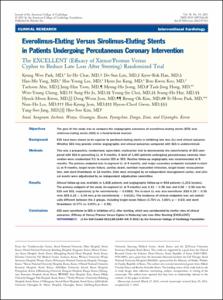KUMEL Repository
1. Journal Papers (연구논문)
1. School of Medicine (의과대학)
Dept. of Internal Medicine (내과학)
Everolimus-Eluting Versus Sirolimus-Eluting Stents in Patients Undergoing Percutaneous Coronary Intervention : The EXCELLENT (Efficacy of Xience/Promus Versus Cypher to Reduce Late Loss After Stenting) Randomized Trial
- Affiliated Author(s)
- 허승호
- Alternative Author(s)
- Hur, Seung Ho
- Journal Title
- Journal of the American College of Cardiology
- ISSN
- 0735-1097
- Issued Date
- 2011
- Abstract
- Objectives The goal of this study was to compare the angiographic outcomes of everolimus-eluting stents (EES) and
sirolimus-eluting stents (SES) in a head-to-head manner.
Background EES have been shown to be superior to paclitaxel-eluting stents in inhibiting late loss (LL) and clinical outcome.
Whether EES may provide similar angiographic and clinical outcomes compared with SES is undetermined.
Methods This was a prospective, randomized, open-label, multicenter trial to demonstrate the noninferiority of EES compared
with SES in preventing LL at 9 months. A total of 1,443 patients undergoing percutaneous coronary intervention
were randomized 3:1 to receive EES or SES. Routine follow-up angiography was recommended at 9
months. The primary endpoint was in-segment LL at 9 months, and major secondary endpoints included in-stent
LL at 9 months, target lesion failure, cardiac death, nonfatal myocardial infarction, target lesion revascularization,
and stent thrombosis at 12 months. Data were managed by an independent management center, and clinical
events were adjudicated by an independent adjudication committee.
Results Clinical follow-up was available in 1,428 patients and angiographic follow-up in 924 patients (1,215 lesions).
The primary endpoint of the study (in-segment LL at 9 months) was 0.11 ± 0.38 mm and 0.06 ± 0.36 mm for
EES and SES, respectively (p for noninferiority = 0.0382). The in-stent LL was also noninferior (EES 0.19 ± 0.35
mm; SES 0.15 ± 0.34 mm; p for noninferiority = 0.0121). The incidence of clinical endpoints was not statistically
different between the 2 groups, including target lesion failure (3.75% vs. 3.05%; p = 0.53) and stent
thrombosis (0.37% vs. 0.83%; p = 0.38).
Conclusions EES were noninferior to SES in inhibition of LL after stenting, which was corroborated by similar rates of clinical
outcomes.
- Department
- Dept. of Internal Medicine (내과학)
- Publisher
- School of Medicine
- Citation
- Kyoo-Rok Han et al. (2011). Everolimus-Eluting Versus Sirolimus-Eluting Stents in Patients Undergoing Percutaneous Coronary Intervention : The EXCELLENT (Efficacy of Xience/Promus Versus Cypher to Reduce Late Loss After Stenting) Randomized Trial. Journal of the American College of Cardiology, 58(18), 1844–1854. doi: 10.1016/j.jacc.2011.07.031
- Type
- Article
- ISSN
- 0735-1097
- Appears in Collections:
- 1. School of Medicine (의과대학) > Dept. of Internal Medicine (내과학)
- 파일 목록
-
-
Download
 oak-aaa-2314.pdf
기타 데이터 / 1.48 MB / Adobe PDF
oak-aaa-2314.pdf
기타 데이터 / 1.48 MB / Adobe PDF
-
Items in Repository are protected by copyright, with all rights reserved, unless otherwise indicated.